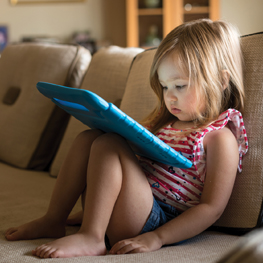
Experts agree that kids learn best when reading books and doing other hands-on activities with their caregivers.
Our screens are ever present, and as we click, sweep, and scroll through our lives, our kids are becoming tech savvy earlier and earlier. With so many games and apps available, it’s easy to put screens into little hands. Yet experts say there are good reasons to hold off. Diana Shepherd, Ph.D., is a professor in the Department of Child Development at California State University, Chico. She says that for children under the age of five, there are few (if any) benefits from using screens - and potentially many harmful consequences. “Infants and toddlers cannot learn from traditional digital media as they can and do from interactions with caregivers,” explains Dr. Shepherd.
How they learn
Young children are wired to learn about the world through their senses. Thomas Kaut is the administrator of a Montessori school which serves children ages two through 12. “Children are active learners,” he says. “Viewing a screen does not provide the same learning opportunity as active exploration with their hands. You can always do better with blocks, sand, and water.”
When a child builds a tower with wooden blocks, they gain skills in all areas of development. They learn about shape, size, texture, weight, and spatial concepts as they pick up and place each piece. They count and sort their blocks. They repeatedly squat and stand, describe their structure, and negotiate with peers. In contrast, the click-and-drag virtual tower offers few of these learning opportunities.
Kaut worries that the more time young children spend with screens, the less time they’re engaged in real-life activities that support cognitive, physical, and social-emotional development. They aren’t moving their bodies, playing outside, and interacting with adults and other children. Problems such as language delay, obesity, and sleep disturbance have been linked to increased screen time and early exposure to screens.
They’re watching us. Are we watching them?
Young children need loving caregivers to sing, read, play, and cuddle with. “The parent is the child’s first and most important teacher,” says Tami Winternitz, director of a preparation program for early childhood education (ECE) teachers. This means children also depend on parents to be good models. “How adults monitor their own screen time in the presence of children often translates into how present they are with the children,” says Winternitz.
Interruptions caused by our devices can negatively impact parent-child interactions. Dr. Shepherd says that when the television is on, even in the background, parents spend less time talking to and playing with their infants. “Positive engagement is reduced when parents are distracted by their devices, diverting their attention to a text, media message alert, snapping photos, or watching television,” she says. What’s more, research indicates that when parents allow these technology-based interruptions, children often respond with negative attention-seeking behavior: whining, crying, clinging, or ‘acting out.’
Be mindful of content
The American Academy of Pediatrics (AAP) recommends that children under 18 months avoid screen exposure except for video chatting. For children up to five years, screen time should be limited to one hour per day of high-quality programming viewed with an adult. “Letting children use media by themselves should be avoided,” says Dr. Shepherd, explaining that adults need to help children interpret what they are seeing and apply it to the real world.
In addition, parents must choose content carefully. On-screen violence can lead to increased aggression, particularly among boys. And young children whose media diet includes lots of fast-paced programming with multiple screen shifts are at greater risk for attentional difficulties. “Parents must ask themselves,” says Dr. Shepherd, “‘What do I want my children to experience and learn from media, and how will this shape their thoughts, perceptions, emotions, and behaviors?’”
Digital books should be previewed, too. Research has shown that distracting elements - sounds, lights, and animation - may decrease a child’s ability to follow the plot. But comprehension increases when an eBook is viewed with an adult and includes features such as word highlighting and repeatable text.
It’s helpful to note that there’s no harm in not exposing a young child to screens. Parents are often misled when toys and apps are marketed as ‘educational.’ They want to provide their child with every advantage, and many parents worry their children will be left behind without access to the latest technology. However, most research indicates young children do not benefit from using these products, and experts agree that kids learn best when reading books and doing other hands-on activities with their caregivers.
Setting boundaries
Though it’s tempting to hand a tablet or phone to a fussy, bored child, this should be avoided. “Using a screen as a babysitter or distractor may make the situation easier on the adult for that moment,” says Winternitz. “However, a screen will not likely provide what the child actually needs: Food, rest, comfort, calm, support, or social interaction.”
Dr. Shepherd also cautions parents against using a screen as the go-to for calming a child - this can lead to problems with a child’s ability to self-regulate. As a busy mom to six children, she knows it’s not always easy. “But the patterns we establish early guide their behaviors as they grow up,” she says. “When they are young, that’s the time to invest in their future by making these choices and by making time to engage with them.”
Activity ideas
Ashley is a freelance writer who enjoys exploring the many facets of parenthood. Her articles have appeared in dozens of parenting publications.
Calgary’s Child Magazine © 2024 Calgary’s Child